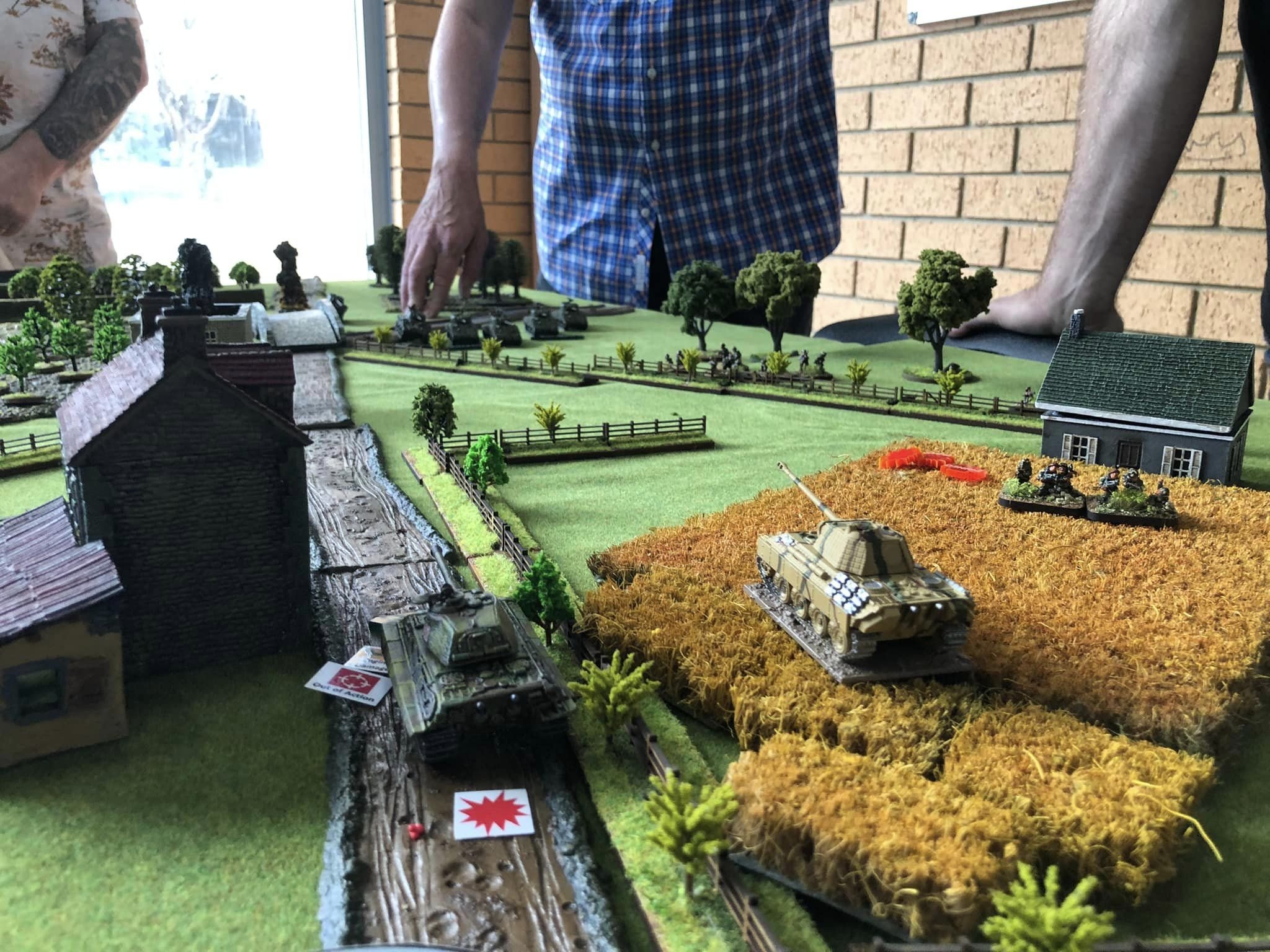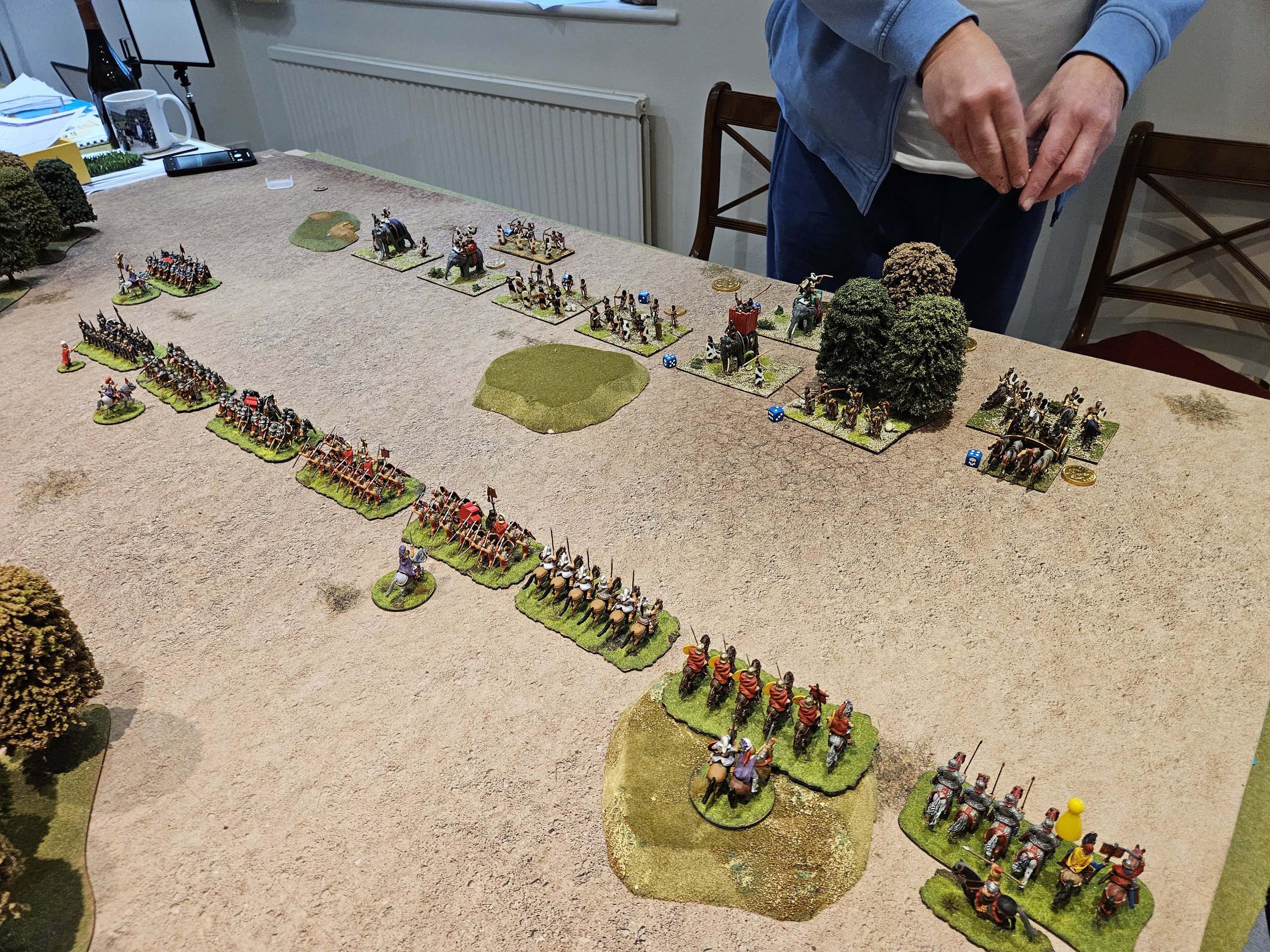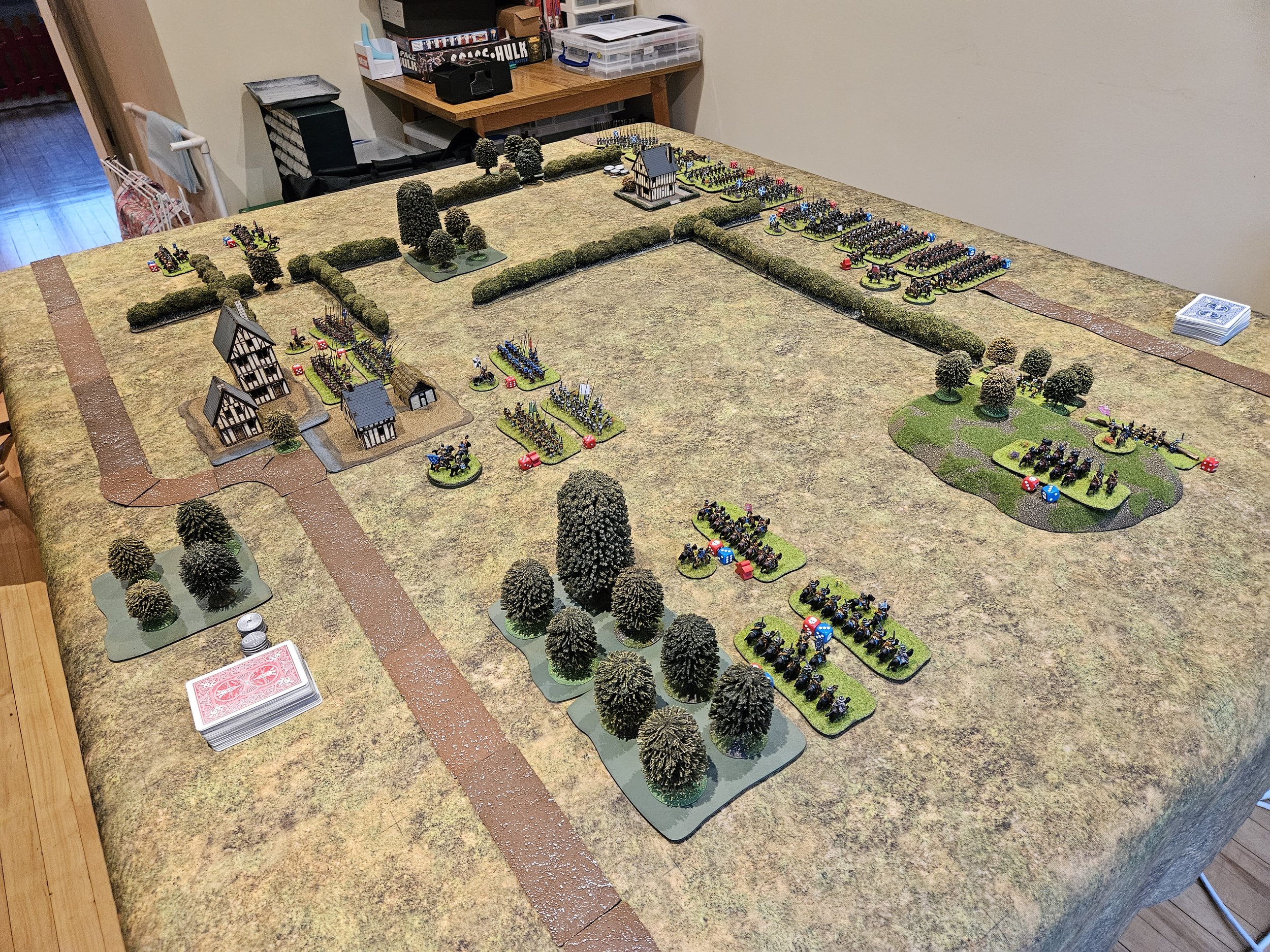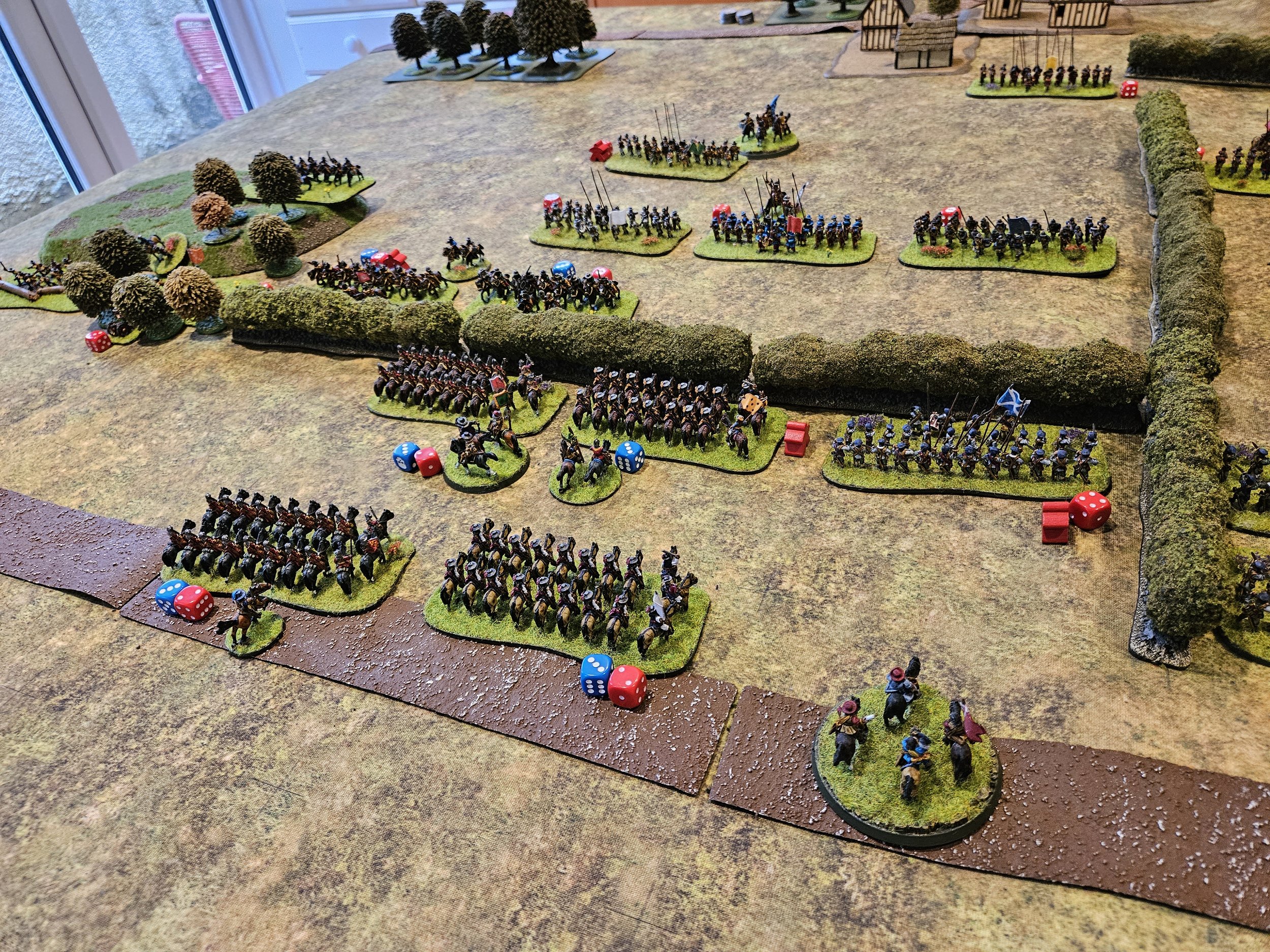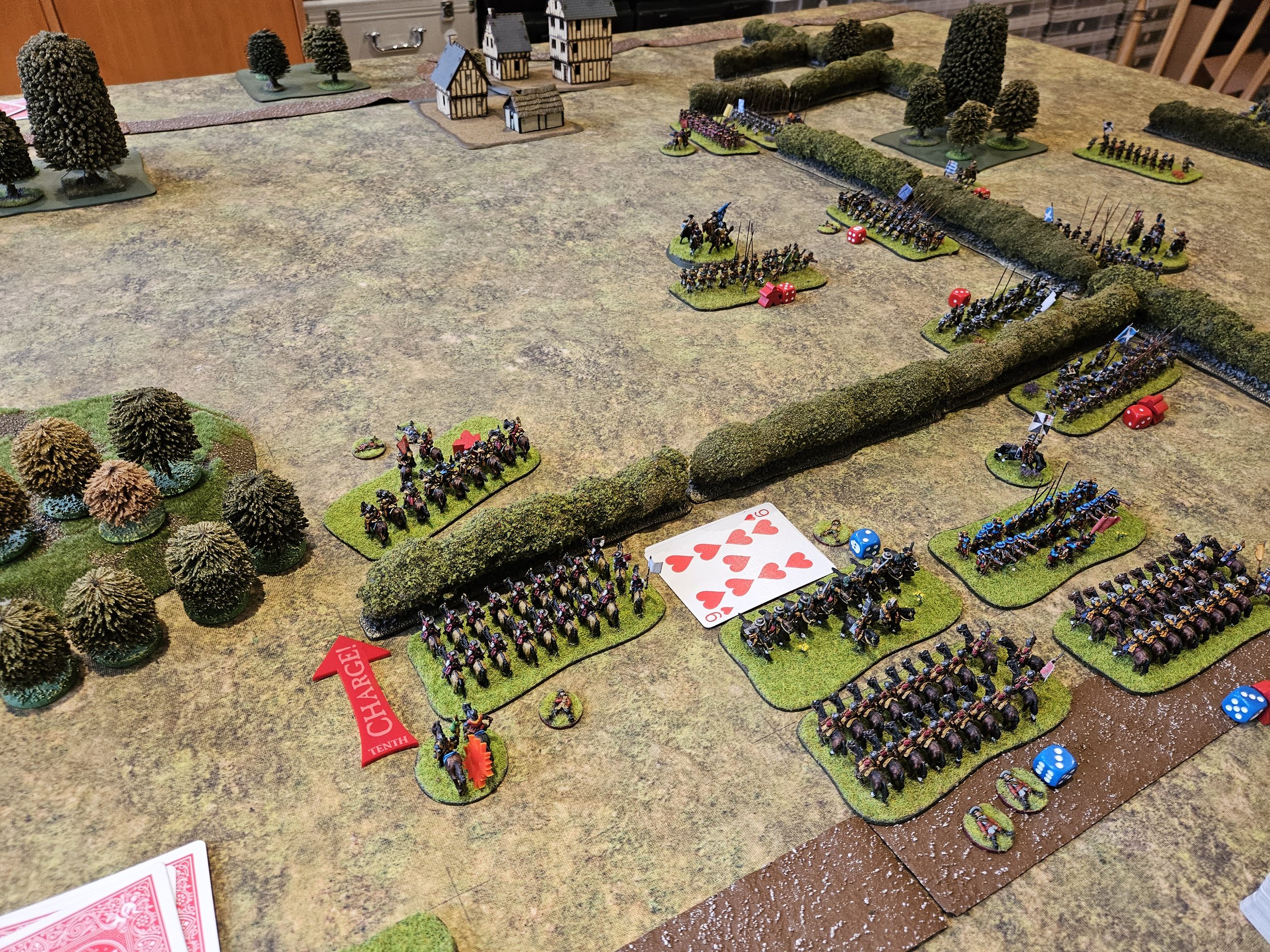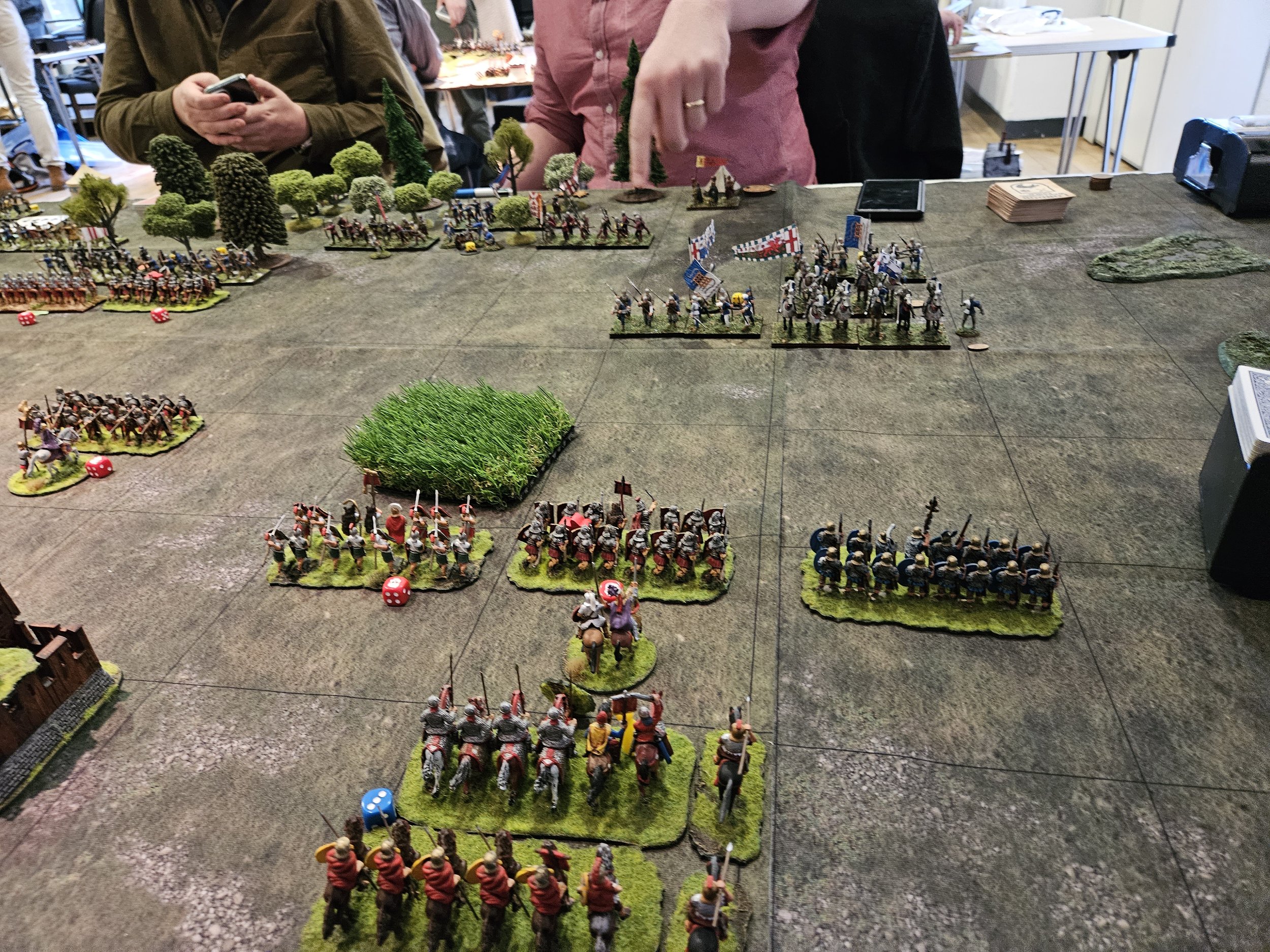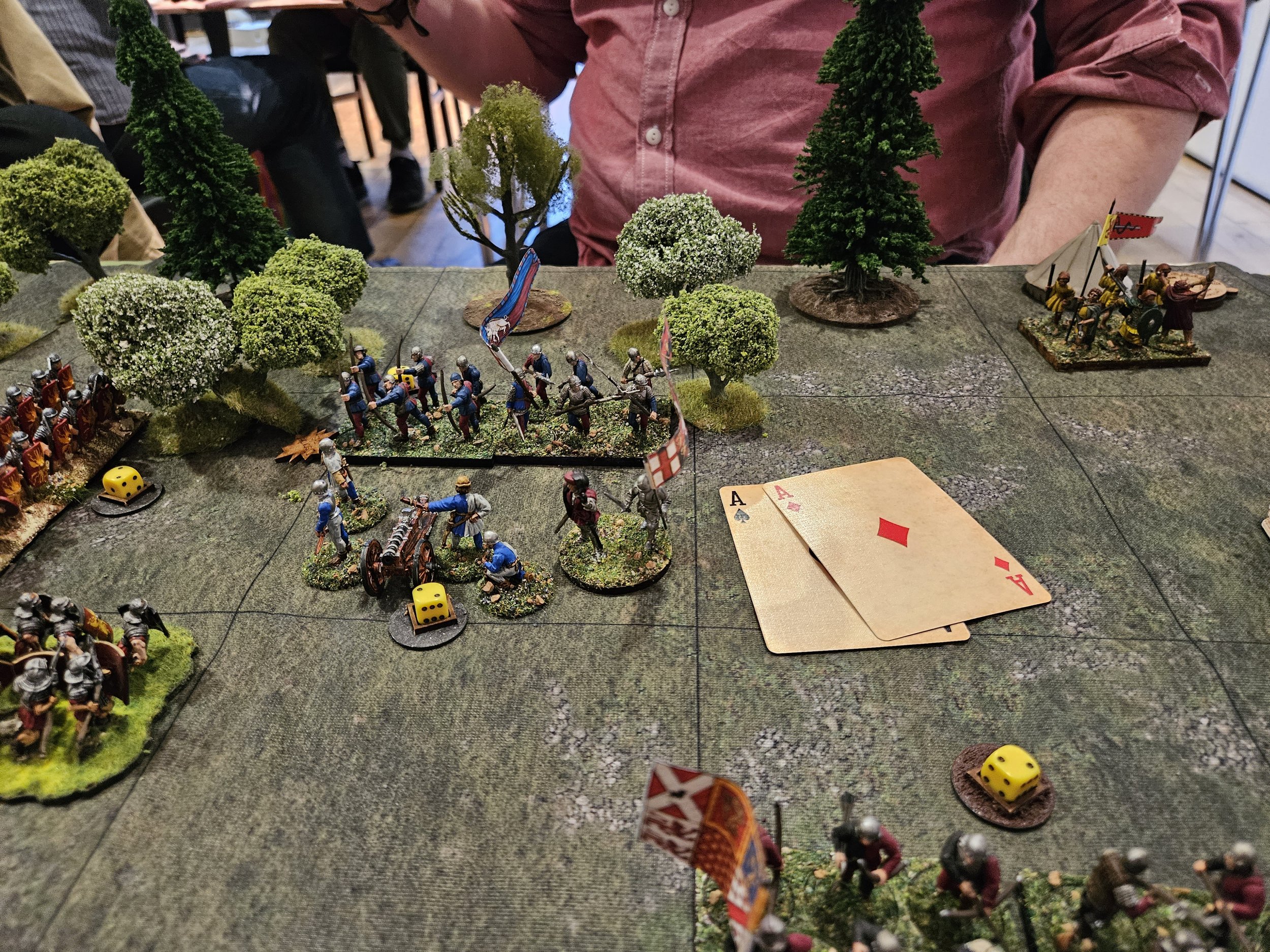TTS AAR: Vikings vs Timurids
/Another game of To The Strongest, this time featuring my Vikings against a Timurid army played by Daughter #1’s boyfriend, Kavan - who hopefully realises that the key to his continued relationship with my offspring is to lose heavily whilst loudly congratulating me on my brilliant play!
A rather empty battlefield: more tundra than fjord!
Beached longships form the Viking camp
The Timurid right wing
As the Vikings are an infantry-only army (no room for horses on those cross-North Sea longship ferries) my big fear was being outflanked and suddenly finding Timurid cavalry in my camp and up my backside!
I therefore put a couple of strong shieldwall units on either flank, rather than concentrating them in the centre and leaving the flanks to the lights as I usually would.
As with many of my more brilliant ideas, this worked well in theory but not in practice, as the cards conspired to prevent my deep shieldwall unit on the left making a very simple diagonal charge to drive two units of horse archers off the table.
This allowed those two units to neatly bypass the shieldwallers, leaving them nicely in a position to turn and either hit me in the rear or to ride for my camps:
“Four or more needed…”
not an ideal outcome
I was also in a bit of trouble on the right, as although I did manage to dispose of his lights there, Kavan had followed up his horsearchers with a couple of meaty heavy cavalry units, who also managed to get around onto my flank and were quickly set to drive at least one shieldwall unit from the field.
Fortunately the top unit in the picture above (the one with the Raven banner) was on fire, and although the bottom unit did indeed get driven from the field, the top unit managed to take out both of the Timurid cavalry units shown, although they did need a bit of luck to do so:
All this action on the flanks did mean that the Timurid centre was a bit weaker than it might have been, and soon another Viking shieldwall unit had broken through towards the Timurid camp, defended only by kharash (driven slaves).
The Timurid camp wasn’t the only one under attack.
Although I had managed to hold off some horse archers, Timurid heavy cavalry charged into one part of my camp, and threatened to take the other, even with two bases of Viking light archers present.
I had started with fifteen victory coins, but was now down to nine, which was about to become six.
Kavan had started with eleven victory coins, but was now down to three. This was unlucky for him, because the Viking unit that threatened his camp had now cleared the kharash off the field, and was able to crash, unopposed, into the Timurid camp.
This was enough, just, to give me the win: a surprise victory for the Norsemen over the more manoeuvrable Timurids.
Here’s the game in longshot…
IABSM AAR: Action at Galmanche
/Sergeant Steiner, who runs an excellent blog that can be found here, has been dabbling with a bit of solo I Ain’t Been Shot Mum.
Click on the picture below to see the first part of his report on playing out the Action at Galmanche scenario from the IABSM rulebook:
TTS AAR: Welsh Open, Game 4: Venetians vs Parthians
/The stage was now set for my final game of the tournament. With two wins and a draw behind me, I would need a substantial win to have any chance of placing towards the top of the leaderboard.
My opponent for this final clash was the formidable Sid and his equally formidable Parthians:
Things started quite well: Sid’s cataphracts on my left attempted to charge forward, drew an Ace, so over-extended themselves into disorder. Unfortunately, I was unable to capitalise on this, and the veteran heavies quickly re-ordered themselves.
Equally unfortunately, this proved the high point of the game for my Venetians!
On the left, a combination of horse archers and heavy cavalry/cataphracts disposed of my Knights, and began curling into my centre. I had my Schioppettiere handgunners to defend my camps, but that meant I couldn’t use them elsewhere.
On my right, the same combination of lights and heavies overwhelmed my troops, although I did manage to do some damage before the flank crumbled.
I was now beginning to think that the Parthians had been taking lessons from the Zulus, as the horns of the buffalo began to close on my centre…
And it wasn’t long before the final curtain as the Parthians on my left flank broke through and took one of my camps and the last of my victory medals!
Excellent play from Sid, leaving me trounced 5-12!
So what did that mean for my overall ranking? Well, two wins, a draw and a loss left me an unexpectedly high 6th place: disappointing but not a complete disaster. Here are the rankings:
Overall a highly enjoyable event, and Firestorm Games is a fantastic venue. I would highly recomend the TTS Competition Circuit to players of the game. Next up are the World Championships “To the World’s Strongest” at the end of Feb.
IABSM AAR: Kiwis on the Road to Orsogna
/Another great battle report from Mark Luther from the Gigabytes Cafe.
This AAR, written in November last year, covers a feint made by a battlegroup of the 18th Armoured Regiment, 22nd Motorised Battalion and some armored cars of the Divisional Cavalry as the 2nd New Zealand Division pushed west towards Orsogna.
Click on the picture below to see all:
TTA AAR: Welsh Open, Game 3: Venetians vs Tang Chinese
/One of the problems with winning your first two games in a competition is that the Swiss Chess system usually in place means that you then have to fight someone else who’s won two games i.e. someone a bit good!
And so it was with the Welsh Open, where I found myself up against Peter and his Tang Chinese. Not it’s fair to say that Peter is a very good player. He’s knows all the rules back to front, and has a very tricky way of getting you on the back foot right from the start of the battle. This was a game that was going to be very tough!
The deployment phase was interesting. Rather than being spread out along the baseline, Peter went for a very one-sided deployment, which I then followed. I told you: very tricky…
The grey patches are woods, by the way
As I advanced forward, Peter didn’t come forward to meet me, but started to shift his troops to the right…
This was obviously part of some cunning plan that I needed to counter…so I moved my men to the right as well…whereupon Peter switched back to advancing on the left…so I shuffled my men back that way to match.
This was a period of move and counter-move with neither side prepared to commit.
One interesting point was that I had drawn the “Lost!” card as my strategem for the game: meaning that one of my units had begun the game lost off the table. I could choose when to bring it on, but it would appear at a random location somewhere on the table’s edge.
That meant that I had to wait until Peter had moved his troops forward a bit, as otherwise I would have just been swamped with flank charges rather than the rear charge that I would be hoping to perform. This was important, as I had taken a bit of a risk and it was a unit of Later Knights that I had declared lost i.e. one of my main fighting bases rather than something like a unit of lights or the like. As it happens, the Knights appeared on the right flank of Peter’s line: you can just see them top right in the photograph, above.
Finally Peter seemed to have had enough of all this shilly-shallying around and sent his heavy cavalry forward. On my left, I lost a unit of Later Knight, but managed to tie up the troops that had broken through with my light cavalry.
In the centre, however, things had gone much more my way, and I had pushed forward and knocked one of his decent cavalry units off the table. Honours were even so far.
Unfortunately my ex-lost Knights hadn’t managed to do much,and had retreated back to their hill to rally and re-arm with lances.
You’ll also see the pikemen, disordered, just by my pack of cards. What I really wanted to do now was to re-order them and move forward again. Here are the cards I drew: activation cards behind the unit, rally cards to their right…
The Pikemen are keen to do anything except rally!
Unfortunately at this point we ran out of time: all that tactical manoeuvring at the beginning of the game had soaked up all the fighting time required later on!
Tallying up the points, the game was an absolute draw: five victory medals versus five victory medals.
What would have happened if we had carried on? Who can say? At the point we ended the battle I was perhaps in a very slightly advantageous position, but that means nothing when facing a player of Peter’s calibre. A draw it was and, as someone said at the time, a result that really opened up the overall tournament ranking overall.
One game to go!
TTS AAR: Welsh Open, Game 2: Venetians vs Later (Eastern) Romans
/My second game at this year’s Welsh Open To The Strongest tournament was against William and his Later (Eastern) Romans.
William’s army was truly massive: 16 victory medals worth versus the mere 12 that I was fielding. The only downside was that many of his troops were raw but, being Auxilia, they still had an averagely decent save.
The terrain was quite heavy (the flat grey patches in the pictures are actually woods) and infantry get a lot of advantage defending against mounted, so I decided to dismount two of my Later Knights units to give me a bit of flexibility in attack.
The action began on my left, with the Roman cavalry advancing quickly towards my lines. As luck would have it, that’s where I’d put one of my dismounted knights…which just goes to show what can happen when you try to be too clever!
No matter: the Roman horse pushed a couple of my light cavalry units back but left themselves in a position where I could charge them from the flank with the foot knights. Should be no problem: I had an officer with the knights, so all I needed for success was anything except a couple of Aces in a row…
Meanwhile the two lines had come together in the centre and on the right as two separate clashes.
On the right, my mounted Knights charged home and had initial success, disordering two of the enemy Auxilia units and leaving them ripe for destruction. unfortunately, his men then turned on their personal forcefields: William spectacularly saving against every attack I could throw at them. I distinctly remember four flank charges going in against disordered Auxilia with no result!
Equally anoyingly, my dismounted knights could see a way through to his three undefended camps, and were the boys to take the nine victory medals that they represented, but just couldn’t get the cards/freedom to do so.
The Aces were also still coming thick and fast!
If you look at the photo above, you’ll see two of them on the table: one (on the far side) stopping my light cavalry from taking his camps (the nine points eluding me again); the other preventing a unit of Later Knights from rallying for the third or fourth time in a row.
By now I had actually killed his cavalry, meaning that the dismounted knights that had disposed of them could head back into the centre to help out the pike- and spearmen, who were under some pressure from advancing Romans. You’ll also see, in the photo below, that on the right I have withdrawn to regroup, although I did kill two to three of his units before doing so.
Things finally turned my way. The unit in front of the pikemen (about to be hit in the flank by dismounted knights) charged forward already disordered. Unfortunately for them, the cards fell my way, and they managed only to impale themselves on the pikes facing them, taking them and their general off the table.
Almost unbelievably, this turned out to be the straw that broke the Roman camel’s back: the four victory medals gained being enough for me to win the game 16-5, despite the fact that it had seemed to me as if I was on the back foot throughout.
Or it might have been that the Knights then crashed into the Bowmen behind the unfortunate infantry, and it was those two victory medals that won me the day. To be honest, I can’t remember which it was!
It had been a thrilling battle: the epitomy of a small number of elites versus a huge number of less than veteran troops. William’s troops’ ability to save against my attacks was truly legendary, and I seriously thought I was going to be swamped at any moment.
Two games in and two wins: good going so far…
TTS AAR: Welsh Open, Game 1: Venetians vs Ayyubid
/This weekend just gone I started off the 2024 To The Strongest competition season with the Welsh Open in Cardiff.
This was held at Firestorm Games: an excellent venue with a cafe, toilets, plenty of light, plenty of parking and plenty of shopping opportunities! Highly recommended to all wargamers if you happen to be in the area.
Last year on the ‘circuit’ I exclusively used my only 28mm army: the Early Imperial Romans. I fancied a change this year, so over Christmas invested in a Later Italian Condotteri army, specifically designed (and sort-of painted up) as Venetians. The Welsh Open would its first airing and I was looking forward to see what it could do, even if I was feeling a little “jaded” after going out into Cardiff for a curry the night before!
My first opponent was Mark and his Ayyubid Egyptians.
The battle started well, with my Venetians outscouting and moving forward to dominate the cengtre of the field. On the right flank, a unit of my Later Knights dashed some Ayyubid heavy cavalry from the table only to have the Someone has Blundered strategem card played on me: not only was my glorious victory annulled, but my Knights decided that they’d heard the dinner bell and ended up facing away from their opponents just asking to be charged up the backside!
“Someone has Blundered” on the right
Melee on the left
Honours even in the centre
The advantage now swung towards the Ayyubids for a bit (my Later Knights seemed to have decided to wear cardboard rather than steel armour!) until a lucky charge knocked back the Ayyubid Al-Halqa al-Khassa veteran cavalry and killed Salah-ad-Din himself!
This caused the momentum to swing back towards the Venetians, and the game now teetered on a knife edge with both sides down to only a few coins left.
The Ayyubid’s salute their fallen leader!
At this point I should mention that Mark and I both forgot that as a ‘great leader’ Salah-ad-Din should have had another save which may have resulted in him being wounded rather than killed.
But forget we did, and a final charge from either the pike of the Condotteri Knights broke the ayyubid morale and the game was mine.
My final charge goes in…
The final result was a 12-8 victory to the Venetians, so a win by the skin of our teeth.
My Later Knights, although very effective when charging forward, proved very vulnerable to enemy action: as you’ll see in the picture above, I only had two of five left at the end of the game.
Mark made superb use of his Someone has Blundered strategem, completely reversing my initial success and firmly taking the initiative, and if it wasn’t for Salah-ad-Din’s untimely demise, things could have been very different.
So one win and on to the next game.
Not an AAR: Romans versus Indians
/As the title says, not a full battle report, but just some pictures of a “noodling game” that friend Peter and I played recently to test out the effect of the new rallying rule.
Early Imperial Romans versus Classical Indians, with the Romans facing a penalty for successfully rallying and the Indians maxing out their longbows and veteran, escorted elephants.
FK&P AAR: Cadmore Hill
/Time for the next installment in the Siege of Norchester English Civil War campaign that friend Rob and I are playing through. The Royalists beat my Parliamentarians in both of the previous games, so I could really do with a win.
The situation is thus: the Parliamentarians are bringing up their sige artillery in order to properly invest Norchester. The Royalists have discovered this and have laid an ambush: if they can destroy the guns, then Norchester survives at least until another siege column can be raised.
Unfortunately for the Royalists, their ambush is triggered early, and that is where the action starts…
The infantry contingent of the Parliamentarian siege train executed a neat right turn to face the oncoming Royalists, but the Dutch horse at the head of the colmn got into all sorts of bother trying to sort themselves out. Finally, one unit of Borders Horse managed to get forwards and prepared to clear away the Royalist Forlorn Hopes.
Meanwhile the Royalist infantry headed forward to engage the enemy, although some confusion in the ranks meant that this advance was staggered rather than co-ordinated.
Meanwhile, at the tail of the Parliamentarian column, not much was happening. Both sides seemed reluctant to move forward, especially the Roundhead commanded shot, who quite frankly disobeyed orders to occupy the nearby farmhouse for three consecutive activations.
In fact, the only units seemingly willing to engage the enemy were the Borders Pioneers right at the back, who steamed up the far left hand side of the table towards some Royalist horse who were apparently having breakfast, then second breakfast, then third breakfast etc.
Back at the proposed ambush site, and some Borders horse swept one of the Royalist Forlorn Hopes from the field, but were then served the same coin by the other. Nothing very conclusive happening here!
Back to the tail end, and much to everyone’s surprise the Borders Pioneers had passively seen off the now-fully-breakfasted Royalist horse: I say “passively” as the Pioneers had no guns, only pikes, and if the Royalist horse had left them alone, each side would have cancelled the other out, but the Cavaliers couldn’t resist the challenge, and effectively charged themselves to death on the Pioneers’ pikes!
That left them free to attempt to curl around the Roundhead left flank, potentially helping their comrades in the centre, who were by now engaged.
Now, however, the Borders Pioneers had realised that they were indeed pioneers, and elected to stop moving towards the action despite a rather inviting flank charge opportunity: presumably waiting for someone to tell them where to dig a hole or two.
The battle was, however, always going to be decided towards the front of the column, where both sides had their main forces, and where a general combat had broken out over the hedge row.
The Royalist had managed to sneak a horse unit around onto the Roundhead flank, using it very effectively to dash some Dutch Horse from the field. This gave the Cavaliers the impetus they needed to push the Parliamentarians back from the hedge, following up to take the battle into open ground. Unfortunately for the Royalists, however, the Roundhead horse then generally rallied and began to fight back.
Both sides were also now quite weary (down to just a couple of victory medals each) so it was all going to be down to who won the next few combats and, on a roll after their fight-back, it was the Parliamentarians who, with a good run of cards, got the bit between their teeth (well, their mounts did!) and sent some enemy Swedish horse fleeing from the field.
This proved the final straw for the Royalists, and the day went to the Parliamentarians.
Aftermath
It had been a very close run thing, with my Roundheads narrowly avoiding a third defeat! As it was, I managed to claw back a couple of medals towards the campaign totals, but that still leaves the Royalists ahead.
On to Stour Road for the next thrilling installment in the campaign.
IABSM AAR: Northern Shoulder Kursk
/Nothing on IABSM for ages and then two AARs arrive at once!
Here’s a photo-report from a game played by Mark Luther and friends at the Gigabytes Cafe in July last year.
The game takes place a few days into Citadel with the German offensive running into a counterattacking Soviet force in wide open terrain.
Click on the picture below to see all:
IABSM AAR: Storming the Citadel V
/It’s been ages since we’ve had an I Ain’t Been Shot Mum after action report, so it’s great to pick this one up from Will Depusoy on the IABSM Facebook Group.
Will and friends are working their way through the PSC Storming the Citadel campaign.This is the report from their table five game: the Soviets are falling back from village of Butovo with the Germans in hot pursuit.
Click on the picture below to see all:
TTS AAR: Timurids versus Normans
/Here’s an After Action Report left over from last year: a game against an old friend of mine, Nog, that I hadn’t seen for ages. He’s only an occasionaly wargamer, and hadn’t played To The Strongest before, so this would be a teaching/learning game rather than all out battle.
I was keen to get my two newest armies onto the table, so Nog would play the Normans and I would play the Timurids. Not historically accurate, maybe, but somewhat mimincing a Crusdaer-rtyle clash!
The Timurids ready for action
Nog’s normans
I had ther initiative, so decided to advnace forward rapidly in order to engage the enemy with bowfire before closing to polish off any left standing.
Unfortunately, my mass advance faltered with my very first card, leaving my troops awkwardly split: some forward, some not.
Amusingly, Nog then proceeded to draw an Ace for his first card, but this time for the foot command in the centre, leaving his horsemen charging forward with the infantry left behind, and a very attractive (to me, anyway) hole in the middle of his line.
In my eagerness to get into bow range I had forgotten that there’s nothing a Norman likes more than charging home, so all those points spent on missile weapons for my Timurids were somewhat wasted as suddenly I had heavy horse all over me!
Both sides rapidly began losing units in the melee that followed. Although my lighter bowmen were outclassed and had to evade backwards, I had enough heavy cavalry of my own to hold the centre, although I did have to deploy the kharash (driven slaves) to bolsetr my line.
As the Normans pushed forward, I did manage to get some of my troops around his left flank and prepared to start rolling the Frenchmen up.
This led to an extraordinary run of cards, as shown in the photo below:
For the unitiated:
Draw a 6 to move into a position to charge the enemy flank
Try to charge, but draw a 2
Use the General to re-draw, pull a 9 and in they go…but combat cards are A and 2 meanign two misses
Need to draw a natural 10 to go in again: 10 drawn, but 2 and 5 for combat mean two more misses
Need to draw another natural 10 to go in a third time: 10 drawn (!) and two 8’s mean two hits and the enemy flee the field
By this time neither of us had many men left at all, and most of mine were on the point of fleeing:
We were, in fact, both down to our last coin, so it was a case of sudden death: whoever loses the next unit loses the game and, as mentioned above, my troops were in a lot worse state than his.
Fortunately, however, the luck remained with me, and a charge with some light troops returning from having evaded, hit the back of some of his, and just managed to dash them from the field. The last coin and the victory were mine!
It had been a great game, full of incident an excitement. We both agreed that I had been foolish to allow the Normans to close with my troops so early on in the game, and that Nog had managed to snatch defeat from the jaws of victory, helped by a final surge of luck on my part at the end of the encounter.
Cracking stuff, and we’re both eagerly awaiting our next battle.
Two the Strongest Tournament: Game Three
/I’m still working my way through a backlog of battle reports that seems to have built up over the last couple of months.
Today features the third and final game at the Two the Strongest doubles tournament organised by the London Wargaming Guild back in November. My partner, Peter, and I had won our first two games and woulkd now face Tim and Matt playing Normans and 100YW French respectively.
The game would be fought across quite an unusual set-up representing a famous battle from history. Apologies, but I can’t remeber which one…but there were a lot of hills on the flanks!
The Romans
The French
For this battle, Peter and I reversed our roles: I would go forward against the Normans whilst Peter hung back against the 100YW French.
My cavalry (Equites Alares and Equites Contarium) duly swung out to the right and advanced forward at speed. They soon met the enemy coming the other way and, much to my delight, almost immediately knocked one Norman unit off the table and sent another to the retreat.
My Roman cavalry have tken some stick this year for their performance on the tabletop, but I must confess that they didn’t put a foot (hoof?) wrong this game: a fitting redemption in the last tournament game of the season.
Meanwhile, my legionaries had also advanced towards the enemy line and pinned them in place as planned. I needed to get a move on, however, as I could see that Peter’s troops were under some pressure from a horde of Late Knights!
My troops began to wheel to their left, ready to roll up the enemy line but, before they could do any significant damage, my cavalry inflicted another loss on the Normans, including killing their commander in chief. This was too much for these early Frenchies to take, and they fled the field, leaving their later compatriots to fight on alone.
The game was a bit of a foregone conclusion from then on, as Peter’s troops were still resisting, leading to an eventual 15-6 victory for the Romans.
Points were totted up and it turned out the Peter and I had actually won the day!
A very good way to end the season, with my first tournament win, and huge thanks to all the Guilders for organising an excellent competition that I shall certainly enter again next year.
If you look at the picture to the right, you will see I am clutching a box of Perry Plastics as a prize (along with the rather marvellous “playing card” trophy). This box turned out to be the naissance of my new 28mm army for 2024, although which later medieval army I will actually paint up is still in doubt at time of writing, along with whether I can actually get it finished in time for the Welsh Open at the end of January!
Two the Strongest Tournament: Game Two
/Peter and I’s second game at the inaugural Two the Strongest Doubles tournament organised by the London Guild of Wargames was against Tom and Nathanial, each fielding a Wars of the Roses army: lots of longbows, billmen and knights!
Our plan was very much the same as in the first game of the tournament. My solid legionaries would hold the bulk of the enemy in place whilst Peter’s lighter cavalry got around the enemy flank and rolled them up. As our opponents wavered at the sight of their flank collapsing, in would go my Roman mincing machine to finish them off.
Much to our surprise, the first stages of the game saw everything going to the plan: Peter’s men got around the right flank of Tom’s troops and started knocking units off the table, then turning to head into the centre. Meanwhile, I advanced cautiously forward, wary of a storm of longbow fire.
Nathaniel also took a cautious approach so, for a time, all the action was on one side. Here’s a montage of these first evolutions:
Then I’m afarid our opponents made what must be considered a fateful mistake.
Concerned about their right flank, they turned some of their units in the centre to the right, intending to take Peter’s legionaries, now heavily engaged with the right side of the enemy line, in the flank. This, of course, left them open to a rapid advance from my troops into their now-exposed left sides, knocking a couple off the table and certainly preventing them intervening to the right as Tom had planned.
At this point Tom’s half of their army collapsed, leading to all his remaining troops being removed from the board and leaving Nathaniel to face the might of the Empire alone!
Now severely outnumbered and already in a poor tactical situation, it was only a matter of time before Nathaniel’s troops were overwhelmed. It also didn’t help that his artillery now showed an alarming propensity to draw Aces!
So in all a fairly convincing 16-0 victory for the Romans, leaving us in a good position overall as we faced the final game of the day.
Two the Strongest Tournament: Game One
/This November just gone, those stalwart men of the London Wargaming Guild put on the first To The Strongest Doubles tournament at the 7 Dials Club in Covent Garden.
The concept was simple: teams of two players, with each player fielding 100 points of army. The armies did not have to be connected but it would obviously be better if they were.
Originally the idea had been for each team to be one experienced player and one less experienced if not novice player, but this requirement was softened in the run-up to the tournament…although personally and, as it turned out somewhat hypocritically, I think enforcing this would actually be an excellent idea for the future.
I say “somewhat hypocritically” because my partner was none other than Peter R., many times champion of many tournaments, which would presumably have made me the novice player!
Our first game was against Sid and Rob: the former also fielding Early Imperial Romans, the latter fielding Polybian Romans.
Our plan was simple: I would pin Sid’s EIR’s in place, whilst Peter lapped around the Polybian left flank. As it happens, our strategy was the same-but-opposite from that adopted by Sid and Rob: Rob would pin Peter’s troops whilst Sid wrapped around my right flank!
The two lines quickly came together, and immediately the flanking generals on each side began to do their thing.
Below left you can see my legionaries holding Sid’s in place whilst below right you can see Sid’s horse and lights attempting to turn my flank:
Fortunately I was able to turn my cavalry to face this threat and, with the Auxilia in Orbis (i.e. fighting to all sides) was able to keep Sid at bay.
Unfortunately for other Rob, Peter is a past master at outflanking, and Rob’s Polybian Romans were soon in a great deal of trouble: their cavalry driven from the field by an endless series of flank attacks from our light troop, leaving his infantry to fall in turn as our cavalry turned on them as Peter’s legions moved into contact.
With his camp falling to some Numidian light horse, Rob was soon forced to remove all his troops from the table, leaving Peter’s men free to come to my aid.
Fighting two opponents at once is never much fun and, despite valiant efforts, Sid’s men were soon reeling from the field as well, leaving us victors 18 points to 9.
TTS @ Warfare: Game Four: EIR versus Tang Chinese
/My fourth and final game at this year’s To The Strongest competition at Warfare was my Early Imperial Romans against Peter Ryding’s Tang Chinese.
Peter is a wily opponent and an expert of using a force that is a mixture of light cavalry, heavy cavalry and solid infantry…and the one thing I didn’t want to happen was him to get his Chinese around the end of my line and outflank my Romans.
As the battle began, Peter immediately went for my flanks with his light cavalry. I didn’t think I’d have a problem on the right: I’d kept that flank strong, intending to deal with the lights then use my superior drilled mobility to curl in and attack his infantry in the centre.
Likewise, on the left, all I would have to do is to move the rear left hand unit of cavalry (with the red cloaks) out to the side and I was sorted.
Unfortunately the poor cards that had been dogging me all day reared their ugly head again, and things did not go according to plan.
On the right, I shot down one of his light horse units almost immediately, and closed with the other to drive it back.
All well and good…but then my central infantry, which I had been intending to get back to the left to engage his main force, just refused to move. Where was my superior drilled mobility? It was buried in Aces!
Oh, and if you look, Peter is making it even more difficult to close with his troops by refusing that flank and presenting me with an oblique line to attack…meaning my men would have even further to go before being able to get stuck in. Clever, very clever!
Worse, the aforementioned red cloaked cavalry on my left had also refused to move as planned, leaving that flank horribly exposed. Peter, never one to miss an opportunity, took full advantage, and soon that flank was completely buggered!
I mean, look at them just sitting there! They obviously haven’t moved since their original deployment when only the smallest movement of one square would have stopped the Tang lights in their tracks.
Now there are those of you who are reading this who are saying “oh look, there’s Rob again complaining about his luck as opposed to admitting he’s playing badly”.
Yes, point taken: you play the cards you’re dealt and all that, and Peter has made no mistakes in executing a very cunning plan…but take a look at the photo below to show what happened as I moved in on his camp: something that could potentially have gained me enough coins to turn the battle my way.
Three Aces are showing…and what’s even more amusing is that for this game that wasn’t even the worst cards that I drew!
Anyway, suffice to say that I didn’t get into the enemy camp or in amongst his infantry before the flank attacks on my left took their toll and the Romans gave way and fled the field, giving Peter a colossal and well-deserved victory.
Results
One colossal loss, one massive victory, and two losing draws gave me a seventh place in the overall competition: a bit of a disappointment to say the least!
But no matter: there was still the Doubles competition at the Seven Dials Club in Covent Garden to come.
My partner?
Peter, of course!
The reports on that tournament will follow in due course…
TTS @ Warfare: Game Three: EIR versus New Kingdom Egyptian
/My third game at this year’s To The Strongest tournament at Warfare was my Early Imperial Romans against Nathaniel’s New Kingdom Egyptians.
Don’t be fooled by the compact look of Nat’s army: there were a lot of light chariot units clumped together, all with bows, so I could expect a hail of bowfire as I closed with the enemy.
I have an NKE army myself (in 15mm) and so was also expecting the Egyptians to rapidly expand their position and attempt to lap around my flanks, always a danger for an infantry army like the Romans. This didn’t happen, however, and Nat kept his troops closed together as he advanced towards me, doubtless determined to just shoot me down head on.
Unfortunately for Nat, this played directly into my strengths.
My Romans can usually soak up arrows or rally off any disorders that they do take on the way in, and love to melee with lesser quality infantry or, even better, light troops. Likewise, my cavalry would be happy to just keep charging his light chariots until they evaded off the table.
And that’s what happened for the rest of the game, as you’ll see from the photos below:
As you can see, enough of my infantry units won their initial clash quickly enough to help out those who hadn’t (the superior manouevrability of the Romans really helping those flank charges go in) and my cavalry did indeed chase his light chariots off the table.
So a workmanlike 13-2 victory for the Romans, with my only loss coming from a General who got in the way of one arrow too many!
TTS @ Warfare: Game Two: EIR versus Polybian Romans
/Game two of the To The Strongest tournament at Warfare, using my Early Imperial Romans, was an interesting match against the Polybian Romans: an earlier-period Roman army that presented in a quincunx formation i.e. deployed in three lines in a chequerboard formation, with the younger hastati in front, followed by the more seasoned principes and the veteran triarii behind. This would allow Nigel’s units to rotate his lines on the spot: meaning that he could rally and bring more pila into action even when in a “zone of control”.
Romans in Quincunx
My plan was not a subtle one: it was to get stuck in with my legionaries whilst trying to lap my cavalry round his flanks. Accordingly, as the game began, I marched my troops forward smartly.
Things started well, with me managing to get a two-on-one advantage on two of his quincunx, one of which I managed to destroy. The picture below shows two legionary units perpendicular to each other as one has just moved into the square where the quincunx was:
Unfortunately this turned out to be the high point of the game for my Romans!
The two battle lines came together and a grinding melee developed with fortunes swaying backwards and forwards between the two sides. Here’s a pic taken just before the lines clashed:
At tbis point my flank forces should have finished with his and come back in to hit the sides of the enemy line, giving me victory.
What actually happened was that my flank forces got bogged down and couldn’t get the local victories I needed to break themselves free to intervene elsewhere. As an example, here’s a unit of enemy horse sandwiched between two of my units: it should have died very quickly, but just kept surviving everything I could throw at it!
All this grinding melee was using up the clock and, before I knew it, time was called.
We totted up the points and I had lost the game by the narrowest of margins: 6 points to 7!
Really interesting to face the Polybian Roman quincunx, well played by my opponent, but a frustrating result.
Two games in to the tournament and two losing draws racked up: not good!












